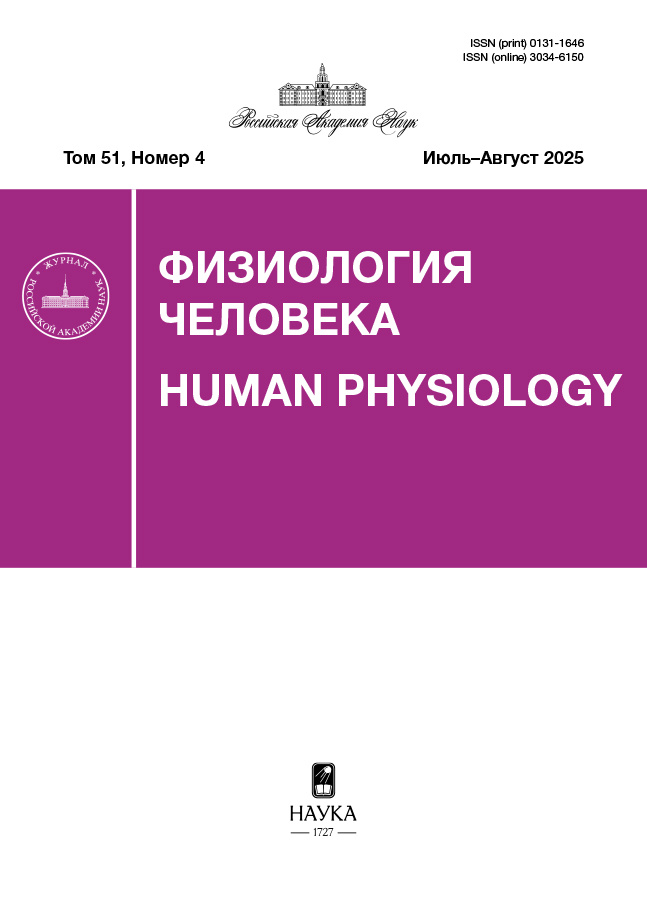The structure of functional synergy that ensures the preservation of the orthograde posture of a person
- Authors: Moiseev S.А.1, Ivanov S.М.1, Mikhailova Е.А.1, Gorodnichev R.M.1
-
Affiliations:
- Velikiye Luki State Academy of Physical Education and Sports
- Issue: Vol 50, No 3 (2024)
- Pages: 26-40
- Section: Articles
- URL: https://gynecology.orscience.ru/0131-1646/article/view/664003
- DOI: https://doi.org/10.31857/S0131164624030039
- EDN: https://elibrary.ru/BUYMRH
- ID: 664003
Cite item
Abstract
The paper considers the process of interaction of individual muscles and muscle groups serving various joints of the body in order to stabilize vertical stability disorders caused by respiratory movements of the chest. The most significant control variables in the process of regulation of intermuscular interaction in order to maintain the stability of the vertical position of the body are considered. The analysis was performed using factorization of muscle electrical activity data, values of articular angles and movements of body segments. It was found that the strategy of maintaining a vertical stance is associated with the control of the hip and neck segments, and with an increase in the disturbing effect, other segments of the body are involved in synergy. An increase in the depth of breathing is accompanied by the inclusion of previously unused muscle modules and a change in the degree of involvement of each muscle in the process of regulating the vertical posture. Such inclusion is reflected in the temporal pattern of activation of synergies at the muscular level, which manifests itself in the formation of additional activation peaks in individual phases of the respiratory cycle. In the process of maintaining vertical stability, muscle activity is moderately associated with the regulation of the position of the general center of mass, and is more directed at the formation of kinematic synergies, including changes in the values of a number of articular angles and simultaneous movement of most body segments. The latter, in turn, stabilize variables important for maintaining equilibrium, and synergetic control at the kinematic level increases as the depth of breathing increases.
Full Text
About the authors
S. А. Moiseev
Velikiye Luki State Academy of Physical Education and Sports
Author for correspondence.
Email: sergey_moiseev@vlgafc.ru
Russian Federation, Velikiye Luki
S. М. Ivanov
Velikiye Luki State Academy of Physical Education and Sports
Email: sergey_moiseev@vlgafc.ru
Russian Federation, Velikiye Luki
Е. А. Mikhailova
Velikiye Luki State Academy of Physical Education and Sports
Email: sergey_moiseev@vlgafc.ru
Russian Federation, Velikiye Luki
R. M. Gorodnichev
Velikiye Luki State Academy of Physical Education and Sports
Email: sergey_moiseev@vlgafc.ru
Russian Federation, Velikiye Luki
References
- Bernshtejn N.A. [Essays on the physiology of movement and the physiology of activity]. M.: Medicina, 1966. 349 p.
- Gel’fand I.M., Gurfinkel’ V.S., Fomin S.V., Cetlin M.L. [Models of the structural and functional organization of some biological systems]. M.: Nauka, 1966. 322 p.
- d’Avella A. Modularity for motor control and motor learning // Adv. Exp. Med. Biol. 2016. V. 957. Р. 3.
- Scholz J., Schöner G. The uncontrolled manifold concept: identifying control variables for a functional task // Exp. Brain Res. 1999. V. 126. № 3. P. 289.
- Latash M. Motor synergies and the equilibrium-point hypothesis // Motor Control. 2010. V. 14. № 3. P. 294.
- Munoz-Martel V., Santuz A., Bohm S., Arampatzis A. Proactive modulation in the spatiotemporal structure of muscle synergies minimizes reactive responses in perturbed landings // Front. Bioeng. Biotechnol. 2021. V. 9. P. 761766.
- Silva P.B., Oliveira A.S., Mrachacz-Kersting N., Kersting U.G. Effects of wobble board training on single-leg landing neuromechanics // Scand. J. Med. Sci. Sports. 2018. V. 28. № 3. Р. 972.
- Rabbi M.F., Pizzolato C., Lloyd D.G. et al. Non-negative matrix factorization is the most appropriate method for extraction of muscle synergies in walking and running // Sci. Rep. 2020. V. 10. № 1. P. 8266.
- Nardon M., Pascucci F., Cesari P. et al. Synergies stabilizing vertical posture in spaces of control variables // Neuroscience. 2022. V. 500. P. 79.
- Alexandrov A.V., Frolov A.A., Massion J. Biomechanical analysis of movement strategies in human forward trunk bending. I. Modeling // Biol. Cybern. 2001. V. 84. № 6. P. 425.
- Kuznetsov N.A., Riley M.A. Effects of breathing on multijoint control of center of mass position during upright stance // J. Mot. Behav. 2012. V. 44. № 4. Р. 241.
- Freitas S.M., Duarte M., Latash M.L. Two kinematic synergies in voluntary whole-body movements during standing // J. Neurophysiol. 2006. V. 95. № 2. Р. 636.
- Clavel L., Attali V., Rivals I. et al. Decreased respiratory-related postural perturbations at the cervical level under cognitive load // Eur. J. Appl. Physiol. 2020. V. 120. № 5. Р. 1063.
- Altenburger K., Bumke O., Foerster O. Allgemeine neurologie. Berlin: Handbuch der Neurologie, 1937. 747 р.
- Moiseev S.A., Pukhov A.M., Mikhailova E.A., Gorodnichev R.M. Methodological and computational aspects of extracting extensive muscle synergies in moderate-intensity locomotions // J. Evol. Biochem. Physiol. 2022. V. 58. № 1. Р. 88.
- Radchenko S. [Regression analysis methodology]. Kiev: Kornіjchuk, 2011. 375 p.
- Nashner L.M., McCollum G. The organization of human postural movements: a formal basis and experimental synthesis // Behav. Brain Sci. 1985. V. 8. № 1. Р. 135.
- Kweon M., Son S.M., Kwon Y.H. The effect of aging on respiratory synergy // J. Phys. Ther. Sci. 2015. V. 27. № 4. Р. 997.
- Schmid M., Conforto S., Bibbo D., D’Alessio T. Respiration and postural sway: detection of phase synchronizations and interactions // Hum. Mov. Sci. 2004. V. 23. № 2. Р. 105.
- Hamaoui A., Gonneau E., Le Bozec S. Respiratory disturbance to posture varies according to the respiratory mode // Neurosci. Lett. 2010. V. 21. № 475(3). Р. 141.
- Moiseev S.A., Gorodnichev R.M. Motor synergies structure variability in different intensity locomotions // Human Physiology. 2022. V. 48. № 4. Р. 370.
- Escalona M.J., Bourbonnais D., Goyette M. et al. Effects of varying overground walking speeds on lower-extremity muscle synergies in healthy individuals // Motor Control. 2021. V. 25. № 2. P. 234.
- Santuz A., Brüll L., Ekizos A. et al. Neuromotor dynamics of human locomotion in challenging settings // iScience. 2020. V. 23. № 1. P. 100796.
- Hodges P.W., Gurfinkel V.S., Brumagne S. et al. Coexistence of stability and mobility in postural control: evidence from postural compensation for respiration // Exp. Brain Res. 2002. V. 144. № 3. Р. 293.
- Krishnamoorthy V., Goodman S., Zatsiorsky V., Latash M.L. Muscle synergies during shifts of the center of pressure by standing persons: identification of muscle modes // Biol. Cybern. 2003. V. 89. № 2. Р. 152.
- Tresch M.C., Cheung V.C., d’Avella A. Matrix factorization algorithms for the identification of muscle synergies: evaluation on simulated and experimental data sets // J. Neurophysiol. 2006. V. 95. № 4. Р. 2199.
- Bizzi E., Cheung V.C. The neural origin of muscle synergies // Front. Comput. Neurosci. 2013. V. 7. Р. 51.
- Torres-Oviedo G., Ting L. Subject-specific muscle synergies in human balance control are consistent across different biomechanical contexts // J. Neurophysiol. 2010. V. 103. № 6. Р. 3084.
- Munoz-Martel V., Santuz A., Ekizos A., Arampatzis A. Neuromuscular organisation and robustness of postural control in the presence of perturbations // Sci. Rep. 2019. V. 9. № 1. Р. 12273.
- Hagio S., Ishihara A., Terada M. et al. Muscle synergies of multidirectional postural control in astronauts on Earth after a long-term stay in space // J. Neurophysiol. 2022. V. 127. № 5. Р. 1230.
- Gel’fand I.M., Tsetlin M.L. [Some methods of control for complex systems] // Uspekhi Mat. Nauk. 1962. V. 17. № 1(103). P. 3.
- Freitas S.M., Duarte M., Latash M.L. Two kinematic synergies in voluntary whole-body movements during standing // J. Neurophysiol. 2006. V. 95. № 2. Р. 636.
Supplementary files













